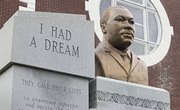The first architect may have lived thousands of years before recorded history, since someone who designs or plans a building fits the generic definition of an architect. Before the advent of hand tools to shape stones or cut wood, a human being somewhere at some time likely dreamed up plans for a structure and built it from mud, brush or whatever was readily available. Therefore, the odds of the modern world knowing the identity of the first architect are astronomical. Recorded history has preserved the identities of several "first architects" in more narrow categories.
First Identified Architect
Historians know Imhotep, who lived around 2600 BCE and served the Egyptian pharaoh Djoser, as the first identified architect in history. Imhotep, credited with designing the first Egyptian pyramid complex, the world's first known extensive stone structure, inspired the later more extravagant pyramids. Two thousand years after his death, the Egyptians deified Imhotep.
First Greek Architects
Greek architecture, developed from the Mycenaean culture, heavily influenced that of the Romans, Persians, and other early civilizations. A plethora of builders carried Greek styles down through the ages into modern times. However, the identity of the first architects who developed the perpetual Doric and Ionic styles is lost to history.
First Chinese Builders
The ancient version of the Great Wall and the identity of its first architect have been lost to history. Yet, archaeologists have shown that around the third century BCE builders in China were constructing sturdy complex walls using interspersed layers of stones and compacted dirt within a wooden framework, known as the hang-tu method of building.
First Architect in the United States
According to PBS, Benjamin Henry Latrobe, born in England in 1764, was America's first architect. One of the first projects Latrobe worked on was a collaborative effort with Thomas Jefferson in designing Virginia's state capitol. Latrobe also designed the south wing of the federal Capitol. His design for the (Baltimore, Maryland) Cathedral of the Assumption of the Blessed Virgin Mary was the nation's first Catholic cathedral. Latrobe's other notable works include the Saint John's Episcopal Church in Washington, DC, and Philadelphia's Bank of Pennsylvania. He is also credited with work on the porticos (covered walkways) of the White House.
First Professional Female Architects
The University of Illinois at Urbana-Champaign (UIUC) champions one of its 1873 graduates, Mary L. Page, as the first woman to earn a degree in architecture in the United States. In addition, UIUC sites Louise Blanchard Bethune as the nation's first woman to work professionally as an architect. However, John H. Lienhard, in an article hosted by the University of Houston, claims Sophie Hayden to be the nation's "first college-trained architect." Hayden graduated from the Massachusetts Institute of Technology in 1890.
Related Articles
References
- Egypt: Imhotep, Doctor, Architect, High Priest, Scribe and Vizier to King Djoser
- PBS: Benjamin Latrobe, America's First Architect
- University of Illinois at Urbana-Champaign: Timeline || Women in Architecture
- University of Houston: No. 1247 Three Women Architects
- "Encarta Encyclopedia"; 2004; Microsoft Corporation.
Writer Bio
Vicki A Benge began writing professionally in 1984 as a newspaper reporter. A small-business owner since 1999, Benge has worked as a licensed insurance agent and has more than 20 years experience in income tax preparation for businesses and individuals. Her business and finance articles can be found on the websites of "The Arizona Republic," "Houston Chronicle," The Motley Fool, "San Francisco Chronicle," and Zacks, among others.











